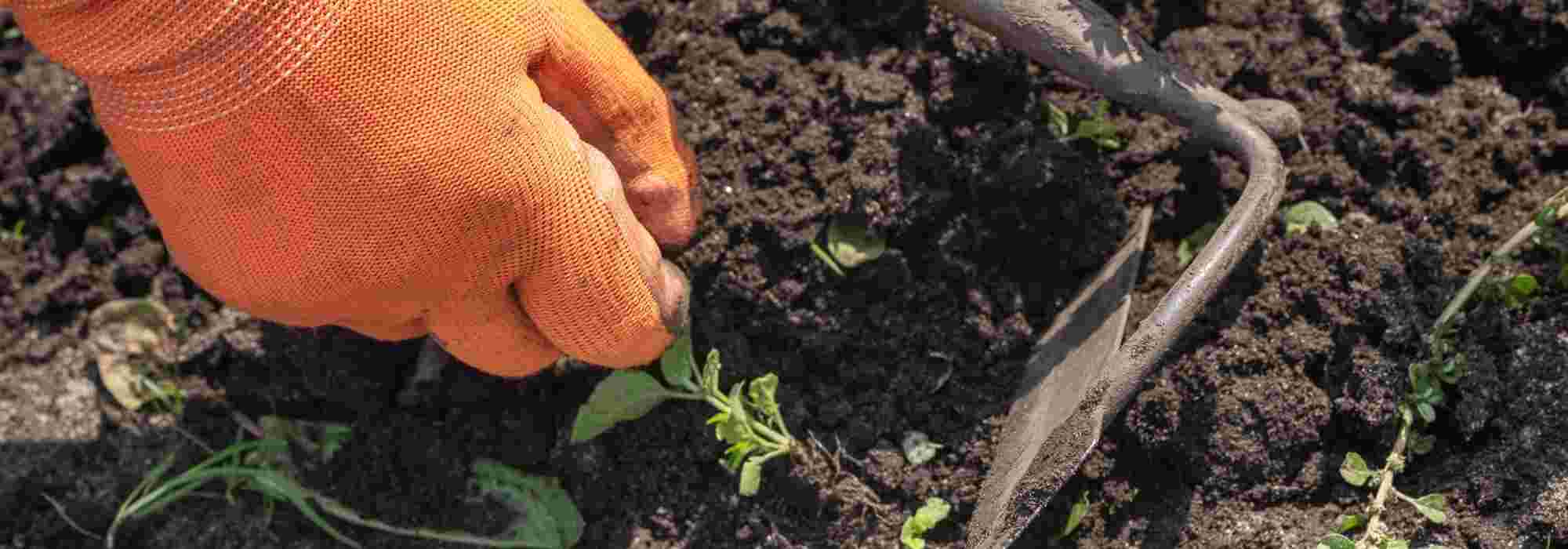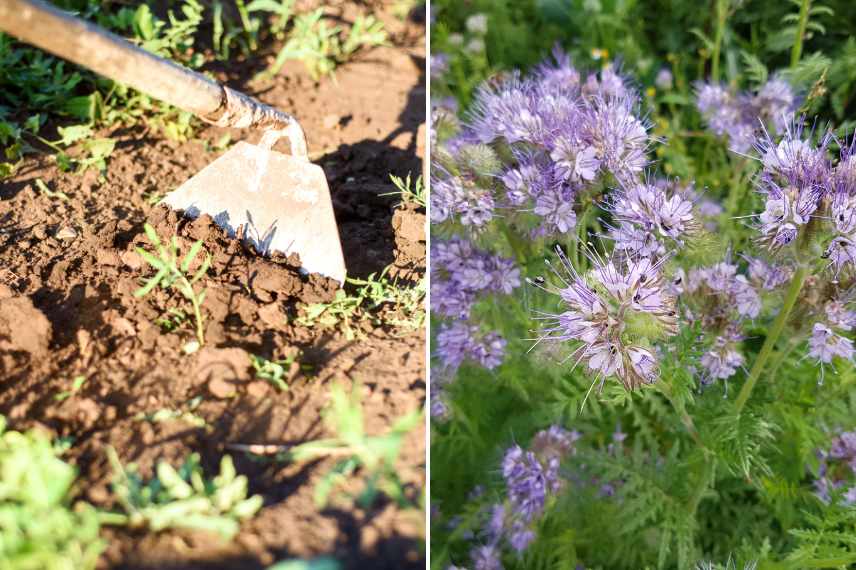
False sowing or green manures: which method to favour against adventive plants?
Comparison of Two Techniques for Getting Rid of Weeds
Contents
Even if so-called “weeds” don’t all deserve this label, they’re certainly not welcome in the vegetable garden, particularly around sowings and young plants. Indeed, an adventive plant is unfair competition for a seedling, as it tends to monopolise air, water and nutrients. For optimal crop performance, it’s best to eliminate weeds from the vegetable garden. Especially since they can also harbour slugs and snails. With chemical or even natural weedkillers now banned, we can turn to two alternative weed management techniques: false sowing and green manure sowing.
Discover our in-depth comparison of these two methods for eliminating adventive plants to help you make an informed choice.
Understanding False Sowing and Green Manures
Before comparing the two weeding techniques, it might be wise to explain their basics. The goal is to eliminate adventive plants that invade vegetable garden plots. Some are merely unsightly, while others are downright harmful due to their tendency to grow very quickly and occupy space at the expense of seedlings and young plants.
False Sowing
This natural weeding method reduces the quantity of adventive seeds in the soil by deliberately triggering their germination. This technique relies on soil preparation similar to actual sowing – loosening the soil with an organic fork or digging fork, breaking up clods with a hand cultivator, then raking to refine the soil. Next, simply water lightly and wait. Adventive seeds typically germinate within about two weeks, or 3-4 weeks depending on the time of year. Then, just hoe or weed to destroy them. You can also use occultation to eliminate young adventive seedlings before proceeding with the actual sowing.
Ideally, false sowing is often done in spring, between April and May, or during any intercrop period, such as in summer before sowing lamb’s lettuce.

False sowing vs green manures
Green Manures
Sowing green manures prevents leaving the soil bare between two vegetable crops. Simply remove the remains of the previous crop, roughly work the soil, then sow a green manure like spring vetch, winter vetch, phacelia, or buckwheat. The latter, by occupying the entire surface, prevents other plants from establishing themselves and is easier to destroy.
In practice, green manures directly compete with weeds through their developed root systems or soil coverage. Green manures belong to different families: Fabaceae or legumes, crucifers, or Poaceae (grasses). Most allow for strict crop rotation, as they are not from the same family as future vegetables.
Advantages and disadvantages of each technique
False Sowing, a Quick and Targeted Solution
False sowing is a simple yet remarkably effective technique for reducing the pressure of adventive plants before cultivation.
It offers numerous advantages:
- Speed of action, as the first adventives emerge within 2 to 3 weeks
- A cost-free method, since false sowing requires no purchase of seeds or specific equipment
- Optimal seedbed preparation: the soil is loosened, levelled, refined, and weeded on the surface
- Flexibility in use: false sowing can be practised at any time, even within short timeframes.
However, there are a few drawbacks to consider:
- Its short-term effect: false sowing is mainly effective against fast-germinating adventives; perennials like mugwort, burdock, couch grass, bindweed, or wood sorrel slip through the net
- A fairly short intervention window: action must be taken at the right time before young shoots harden
- Soil disturbance: repeated false sowing can disrupt and weaken the structure of the most sensitive soils.
Green Manures, a Multifunctional Approach
Sowing green manures helps limit space for adventives while benefiting from their many advantages: improved soil structure, increased organic matter, stimulation of microfauna…
Logical benefits of green manures:
- Long-lasting coverage: as green manures take slightly longer to develop, the soil remains protected for a longer period
- Soil enrichment: beyond suppressing adventive growth, green manures enrich the soil, trap nitrates, and prepare the ground for subsequent crops
- Simplified soil work: thanks to their taproot systems, some green manures aerate and structure the soil
Yet, green manures also have minor drawbacks:
- More demanding implementation: species must be chosen carefully, and sowing schedules respected—some green manures are sown in spring, others in late summer. Managing their destruction through mowing also requires some experience, time, and effort
- Risk of poorly controlled competition: destroying green manures too late can harm the following crop
- A need for time: the weeding effect becomes apparent over the duration of a growing cycle.

Spring and winter vetches are effective green manures against adventives
A comparison based on the type of cultivation
The choice and effectiveness of any particular weeding technique also depends on the context. Indeed, the type of crop, the season, the type of soil, the climate or short and long-term objectives are all criteria to consider when adopting false sowing or green manures.
In a family vegetable garden
Thus, in a vegetable garden, where rotations are short and crops follow each other rapidly, false sowing is often the best option. Its quick execution allows effective weeding of a bed in just two to three weeks before sowing or planting.
For example, for growing carrots or radishes, which are particularly sensitive to competition during germination, false sowing can make all the difference. The advantage is even greater on permanent beds where soil conditions are already well controlled.
On the other hand, green manures find less room here due to the time they require to fully express their potential. Unless integrating a winter cover (such as rye or vetch) between two main crops, their use remains limited to very specific windows.
In poor or degraded soil
When the soil is tired, compacted or depleted, green manures are doubly beneficial. Not only do they limit the proliferation of adventive plants, but they also contribute to soil restoration by improving structure, adding standing crop, and stimulating soil fauna.
False sowing, though still useful, does not address the root causes of excessive herb growth. It treats the symptoms rather than the cause.
Another strategy: combining green manure and false sowing
Since false sowing and green manure sowing are not incompatible, the two methods can also be combined for sustainable management of adventive plants.
The first option involves carrying out a false sowing just before planting a green manure. This method quickly cleans the soil by reducing the surface stock of adventive seeds before moving to a phase of plant cover. For example, at the end of summer, you can prepare the soil with a false sowing, then sow white mustard or a mix of rye and vetch. The soil is then clean and immediately covered, greatly limiting autumn regrowth of adventive plants.
A second option relies on different timing: after a spring or winter green manure, a false sowing can help manage opportunistic adventives that might take advantage of bare soil after the cover crop is destroyed. This scenario often occurs when destruction is done by mowing, allowing light to return to the soil. A simple hoeing then stimulates rapid germination of adventives, which are destroyed before planting the main crop.
It is also possible to alternate the two techniques depending on the season and the type of crop planned—false sowing in spring and summer, green manures in the off-season.
- Subscribe!
- Contents
































Comments